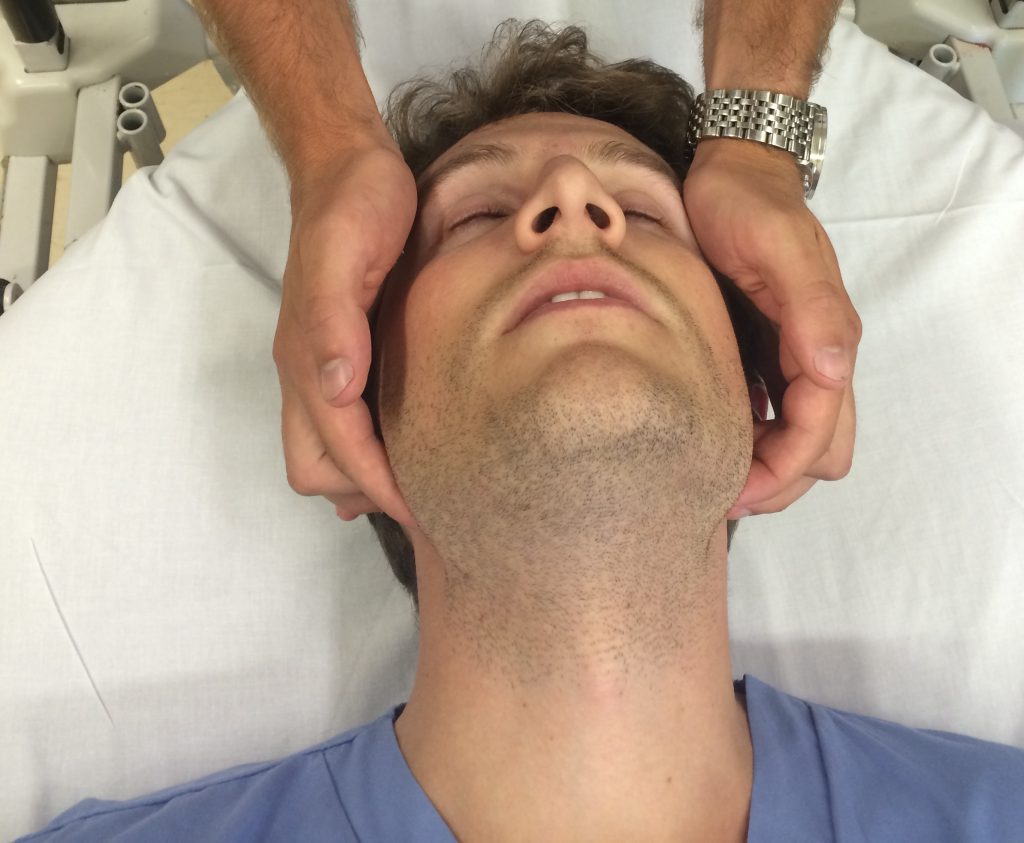In emergency medicine, the difference between life and death often comes down to the first few minutes of care. Among the critical skills that every healthcare professional and first responder must master is the jaw thrust maneuver—a simple yet powerful technique that can maintain an open airway in unconscious patients. But what makes this maneuver so effective? The answer lies in understanding the intricate anatomy of the human airway and how this life-saving technique works with the body’s natural structure.
What Is the Jaw Thrust Maneuver?
The jaw thrust maneuver is a basic airway management technique designed to open and maintain a patient’s airway without manipulating the cervical spine. When performed correctly, the jaw thrust maneuver lifts the jaw forward, preventing the tongue from blocking the back of the throat and obstructing airflow to the lungs.
To execute a proper jaw thrust maneuver:
- Position yourself at the patient’s head
- Place your fingers behind the angles of the patient’s lower jaw
- Lift the jaw upward and forward using firm pressure
- Avoid tilting the head backward
- Maintain this position to keep the airway open
This seemingly simple procedure works because it addresses a fundamental anatomical challenge that occurs when a person loses consciousness.
The Anatomy Behind the Jaw Thrust Maneuver
When a person becomes unconscious, muscle tone decreases throughout the body, including the muscles that support the jaw and tongue. The tongue, which is attached to the mandible (lower jawbone), naturally falls backward due to gravity and relaxation of the genioglossus muscle, potentially blocking the pharynx (throat).
The human airway consists of several key structures:
- Oral Cavity: The entrance to the respiratory tract
- Pharynx: Divided into the nasopharynx, oropharynx, and laryngopharynx
- Larynx: Contains the vocal cords and connects the pharynx to the trachea
- Trachea: The main airway to the lungs
The tongue is anchored to the mandible by the genioglossus muscle. When unconscious, this muscle relaxes, allowing the tongue to fall back against the posterior pharyngeal wall, creating an obstruction. The jaw thrust maneuver counteracts this by physically moving the mandible forward, which in turn pulls the tongue away from the back of the throat.
When Is the Jaw Thrust Maneuver Indicated?
The jaw thrust maneuver is primarily indicated in the following situations:
Unconscious Patients with Potential Spinal Injuries
For patients with suspected cervical spine injuries, the jaw thrust maneuver is the preferred method for opening the airway because it minimizes neck movement. Unlike other airway opening techniques, a properly performed jaw thrust maneuver can be executed without extending the neck, which could potentially worsen a spinal injury.
During CPR and Basic Life Support
The jaw thrust maneuver is a crucial component of CPR and basic life support protocols. When a person experiences cardiac arrest, ensuring an open airway is one of the first steps in the resuscitation process. The jaw thrust maneuver allows rescuers to establish and maintain that airway while preparing for rescue breaths or before connecting advanced airway devices.
Patients Under Anesthesia
Anesthesiologists and nurse anesthetists regularly use the jaw thrust maneuver during surgical procedures. General anesthesia causes the same muscle relaxation as unconsciousness, leading to potential airway obstruction. The jaw thrust maneuver helps maintain airway patency during induction, maintenance, and emergence from anesthesia.
Obstructive Sleep Apnea Interventions
Some continuous positive airway pressure (CPAP) masks incorporate elements of the jaw thrust principle to help keep the airway open during sleep for patients with obstructive sleep apnea.
The Effectiveness of the Jaw Thrust Maneuver
Research has consistently demonstrated the effectiveness of the jaw thrust maneuver in opening obstructed airways. Studies using magnetic resonance imaging (MRI) have shown that the maneuver increases the cross-sectional area of the pharynx by moving the tongue and soft tissues forward, away from the posterior pharyngeal wall.
The jaw thrust maneuver works by:
- Displacing the mandible anteriorly
- Moving the attached tongue forward
- Tensing the anterior pharyngeal muscles
- Lifting the epiglottis from the glottic opening
- Creating a clear passage for air to flow to the lungs
This biomechanical action effectively converts a collapsed airway into an open one, allowing for spontaneous or assisted ventilation.
Jaw Thrust Maneuver vs. Chin Lift: Understanding the Difference
While both the jaw thrust maneuver and the chin lift technique aim to open an obstructed airway, there are significant differences between these two approaches that healthcare providers must understand.
The Chin Lift Technique
The chin lift involves placing one hand on the patient’s forehead to tilt the head backward while using the fingers of the other hand to lift the chin. This head-tilt/chin-lift combination is commonly taught in basic first aid and CPR courses for the general public because it’s relatively simple to learn and perform.
Key Differences Between Jaw Thrust and Chin Lift
- Spinal Manipulation:
- Jaw thrust: Can be performed without extending the cervical spine
- Chin lift: Involves tilting the head backward, which extends the neck
- Technique Complexity:
- Jaw thrust: Requires more precise finger placement and strength
- Chin lift: Generally easier for lay rescuers to perform correctly
- Clinical Applications:
- Jaw thrust: Preferred for trauma patients with potential spinal injuries
- Chin lift: Often used in non-trauma situations where spinal injury is not a concern
- Anatomical Effect:
- Jaw thrust: Works by pulling the mandible and attached tissues forward
- Chin lift: Works by extending the neck, which stretches anterior neck structures and lifts the tongue off the posterior pharyngeal wall
- Effectiveness:
- Jaw thrust: May provide a more secure airway in deeply unconscious patients
- Chin lift: Usually adequate for most basic airway management scenarios
Healthcare professionals must be proficient in both techniques and understand when each is appropriate based on the patient’s condition and the clinical scenario.
Performing the Perfect Jaw Thrust Maneuver
The effectiveness of the jaw thrust maneuver depends on proper technique. Here’s a detailed breakdown of how to perform this life-saving procedure correctly:
- Position yourself: Kneel or stand at the top of the patient’s head
- Place your hands: Position your index and middle fingers behind the angles of the patient’s mandible (jawbone), just below the ears
- Apply pressure: Using your fingertips, lift the jaw upward and forward without tilting the head
- Maintain position: Continue the forward pressure on the jaw angles until the airway is secured or additional interventions are implemented
- Monitor effectiveness: Look for chest rise and fall, listen for breathing sounds, and feel for air movement from the nose and mouth
Common errors when performing the jaw thrust maneuver include:
- Placing fingers on soft tissue instead of on the bone of the mandible
- Applying insufficient forward pressure
- Inadvertently tilting the head
- Pressing on the soft tissues under the jaw, which can compress the airway
- Not maintaining the jaw thrust while performing other interventions
Regular practice on training mannequins under professional supervision helps healthcare providers develop the muscle memory and technique refinement necessary for effective emergency airway management.
Advanced Applications of the Jaw Thrust Maneuver
Beyond basic life support, the jaw thrust maneuver serves as a foundation for more advanced airway management techniques.
During Endotracheal Intubation
Anesthesiologists and emergency physicians often use a modified jaw thrust maneuver during endotracheal intubation procedures. This helps optimize the view of the glottic opening by lifting the epiglottis and exposing the vocal cords, facilitating proper tube placement.
With Airway Adjuncts
The jaw thrust maneuver is frequently used in conjunction with airway adjuncts such as:
- Oropharyngeal airways (OPAs)
- Nasopharyngeal airways (NPAs)
- Supraglottic airway devices (like laryngeal mask airways)
Even when these devices are in place, maintaining a jaw thrust can improve their effectiveness by optimizing airway alignment.
In Pediatric Patients
The jaw thrust maneuver must be modified for infants and children due to their different anatomy. Their airways are narrower, softer, and more flexible, and their tongues are proportionally larger relative to the oral cavity. Healthcare providers must use gentler pressure and be mindful of the delicate structures when performing a jaw thrust on pediatric patients.
The Science of Airway Obstruction
Understanding why the jaw thrust maneuver works requires knowledge of the physiological mechanisms of airway obstruction. When a person loses consciousness, several factors contribute to potential breathing difficulties:
- Muscular relaxation: Loss of tone in the genioglossus and pharyngeal muscles
- Gravitational effects: The tongue falls backward when a person is supine
- Anatomical relationships: The proximity of the tongue base to the posterior pharyngeal wall creates a natural bottleneck
- Loss of protective reflexes: Unconscious patients cannot clear their airways
The jaw thrust maneuver addresses these issues by mechanically repositioning the anatomical structures to create and maintain an open air passage. By moving the mandible forward, the attached tongue and associated soft tissues also move away from the posterior pharyngeal wall, allowing air to flow freely.
Training and Certification in the Jaw Thrust Maneuver
Healthcare providers, first responders, and even concerned citizens can benefit from proper training in airway management techniques, including the jaw thrust maneuver. Professional certification courses provide both the theoretical knowledge and practical skills needed to perform these life-saving interventions correctly.
Training typically covers:
- Airway anatomy and physiology
- Recognition of airway obstruction
- Proper jaw thrust technique
- Alternative airway management methods
- Special considerations for pediatric and geriatric patients
- Integration with other resuscitation procedures
Conclusion: The Critical Importance of Proper Airway Management
The jaw thrust maneuver exemplifies how understanding human anatomy allows us to develop simple yet effective life-saving techniques. By working with the body’s structure—moving the mandible forward to pull the attached tongue away from the pharyngeal wall—healthcare providers can quickly establish a patent airway in emergencies.
For those working in healthcare, emergency response, or anyone responsible for the welfare of others, mastering the jaw thrust maneuver isn’t just about learning a technique—it’s about understanding the “why” behind the method. This anatomical knowledge empowers providers to adapt the technique to different situations and patient conditions, potentially saving countless lives.
Ready to Master the Jaw Thrust Maneuver? Take Action Today!
Don’t wait until an emergency happens to learn these critical skills. CPR St. Louis, an American Heart Association training site, offers comprehensive certification and renewal courses in BLS for Healthcare Providers, ACLS, PALS, and CPR and First Aid. Our classes cover essential techniques like the jaw thrust maneuver in a stress-free, hands-on learning environment.
Whether you’re seeking BLS certification in St. Louis for professional requirements or CPR certification in St. Louis for personal preparedness, our expert instructors will ensure you develop the confidence and competence to respond effectively in emergencies.
Contact CPR St. Louis today—because when seconds count, proper training makes all the difference. Recognized as offering the best CPR training in the St. Louis area, we’re committed to empowering our community with life-saving skills.





